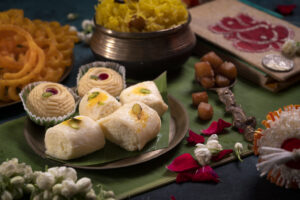Authentic Gatte Ki Sabzi – A Rajasthani Delight Recipe
Cuisine: Rajasthani
Gatte Ki Sabzi is a traditional dish from Rajasthan, renowned for its vibrant flavors and unique texture. The dish consists of gram flour dumplings cooked in a spicy yogurt sauce, delivering a delightful mix of creamy and spicy, a true reflection of Rajasthani cuisine. It’s typically enjoyed with roti or rice and is a staple during festive occasions and family gatherings.Rajasthani
Table of Contents
ToggleWhile Gatte Ki Sabzi stands out as a unique dish, there are various renditions across India. Some regional versions include the use of different spices or the addition of vegetables to suit local tastes. However, our recipe honors the classic preparation, ensuring that you experience the authentic essence of this dish, which is considered one of the best variations available.
Ingredients for Gatte Ki Sabzi
| Gram Flour (Besan) | 1 cup |
| Yogurt | 1/2 cup |
| Turmeric Powder | 1/2 tsp |
| Red Chilli Powder | 1 tsp |
| Coriander Powder | 1 tsp |
| Cumin Seeds | 1/2 tsp |
| Ginger-Grated | 1 tsp |
| Green Chilli (chopped) | 1 |
| Salt | to taste |
| Oil | 2 tbsp |
| Water | as required |
| Fresh coriander leaves | for garnish |
Preparation Method for Gatte Ki Sabzi
Creating the perfect Gatte Ki Sabzi involves a few simple steps that combine to create a rich and flavorful dish. Let’s break it down:
- In a mixing bowl, combine gram flour with salt, turmeric, red chilli powder, coriander powder, and cumin seeds.
- Add water gradually to form a stiff dough. Let it rest for about 15 minutes.
- Meanwhile, prepare the gravy by whisking yogurt with turmeric, red chilli powder, and salt in another bowl.
- Roll the dough into cylindrical shapes and steam them for 20 minutes until cooked through.
- Once cooled, slice the steamed gatte into small pieces.
- Heat oil in a pan, add grated ginger and green chilli, and sauté for a minute.
- Add the yogurt mixture and bring it to a boil, then gently add the gatte pieces.
- Simmer for 10 minutes, adjusting the salt and spices to taste.
- Garnish with fresh coriander leaves before serving.
Nutritional Information
Calories per Serving: 150
| Calories | 150 |
| Protein | 6g |
| Fat | 7g |
| Carbohydrates | 15g |
| Fiber | 2g |
When and How to Serve
This Gatte Ki Sabzi makes for a perfect meal option for Kids and deliciously fits into an Office Tiffin. The rich, creamy gravy and the flavor-packed gatte dumplings provide just the right amount of satisfaction for a school lunch or as a delightful office meal. Pair it with soft rotis or steamed rice, and it truly becomes a wholesome lunch that is both tasty and nourishing.
Cultural Significance and Story Behind Gatte Ki Sabzi
Gatte Ki Sabzi is not just a dish; it is a culinary story that speaks of the rich heritage of Rajasthan. Traditionally prepared during festive occasions and celebrations, it embodies the spirit of Rajasthani hospitality. The dish symbolizes the resourcefulness of Rajasthani people, who have thrived in a sparse, arid landscape by using ingredients like gram flour and yogurt, which are easy to store and versatile. It is also popular during the winter season as it provides warmth and comfort through its rich flavors and spices.
As this dish evolves into a favorite among food enthusiasts all over India, the potential for creating a business around Gatte Ki Sabzi is immense. With a growing trend for regional and authentic cuisines, launching a brand focused on Rajasthani cuisine could yield positive results. Existing brands like ‘Rajasthan’s Royal Platter’ already tap into this niche, yet with innovative recipes and a strong social media presence, there’s an opportunity for uniqueness. Consider offering fresh, ready-to-cook Gatte Ki Sabzi kits to capture the market that values both convenience and authenticity.
In conclusion, Gatte Ki Sabzi enriches our palate and connects us with the cultural roots of Rajasthan. Especially in times where home-cooked meals are cherished more than ever, this dish’s nostalgia and flavors can resonate with many, making it a worthy venture for those passionate about culinary traditions.




